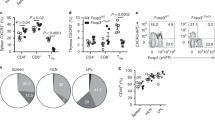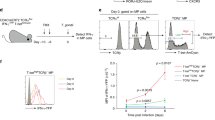Abstract
CD8+ T cells have a crucial role in resistance to pathogens and can kill malignant cells; however, some critical functions of these lymphocytes depend on helper activity provided by a distinct population of CD4+ T cells. Cooperation between these lymphocyte subsets involves recognition of antigens co-presented by the same dendritic cell, but the frequencies of such antigen-bearing cells early in an infection and of the relevant naive T cells are both low. This suggests that an active mechanism facilitates the necessary cell–cell associations. Here we demonstrate that after immunization but before antigen recognition, naive CD8+ T cells in immunogen-draining lymph nodes upregulate the chemokine receptor CCR5, permitting these cells to be attracted to sites of antigen-specific dendritic cell–CD4+ T cell interaction where the cognate chemokines CCL3 and CCL4 (also known as MIP-1α and MIP-1β) are produced. Interference with this actively guided recruitment markedly reduces the ability of CD4+ T cells to promote memory CD8+ T-cell generation, indicating that an orchestrated series of differentiation events drives nonrandom cell–cell interactions within lymph nodes, optimizing CD8+ T-cell immune responses involving the few antigen-specific precursors present in the naive repertoire.
This is a preview of subscription content, access via your institution
Access options
Subscribe to this journal
Receive 51 print issues and online access
$199.00 per year
only $3.90 per issue
Buy this article
- Purchase on Springer Link
- Instant access to full article PDF
Prices may be subject to local taxes which are calculated during checkout





Similar content being viewed by others
References
Germain, R. N. & Castellino, F. Co-operation between CD4+ and CD8+ T cells: when, where, and how. Annu. Rev. Immunol. (in the press)
Bevan, M. J. Helping the CD8+ T-cell response. Nature Rev. Immunol. 4, 595–602 (2004)
Kaech, S. M., Wherry, E. J. & Ahmed, R. Effector and memory T-cell differentiation: implications for vaccine development. Nature Rev. Immunol. 2, 251–262 (2002)
Keene, J. A. & Forman, J. Helper activity is required for the in vivo generation of cytotoxic T lymphocytes. J. Exp. Med. 155, 768–782 (1982)
Bourgeois, C., Rocha, B. & Tanchot, C. A role for CD40 expression on CD8+ T cells in the generation of CD8+ T cell memory. Science 297, 2060–2063 (2002)
Guerder, S. & Matzinger, P. A fail-safe mechanism for maintaining self-tolerance. J. Exp. Med. 176, 553–564 (1992)
Miller, M. J., Wei, S. H., Parker, I. & Cahalan, M. D. Two-photon imaging of lymphocyte motility and antigen response in intact lymph node. Science 296, 1869–1873 (2002)
Miller, M. J., Wei, S. H., Cahalan, M. D. & Parker, I. Autonomous T cell trafficking examined in vivo with intravital two-photon microscopy. Proc. Natl Acad. Sci. USA 100, 2604–2609 (2003)
Miller, M. J., Hejazi, A. S., Wei, S. H., Cahalan, M. D. & Parker, I. T cell repertoire scanning is promoted by dynamic dendritic cell behavior and random T cell motility in the lymph node. Proc. Natl Acad. Sci. USA 101, 998–1003 (2004)
Bousso, P. & Robey, E. Dynamics of CD8+ T cell priming by dendritic cells in intact lymph nodes. Nature Immunol. 4, 579–585 (2003)
Mempel, T. R., Henrickson, S. E. & Von Andrian, U. H. T-cell priming by dendritic cells in lymph nodes occurs in three distinct phases. Nature 427, 154–159 (2004)
Bennett, S. R. et al. Help for cytotoxic-T-cell responses is mediated by CD40 signalling. Nature 393, 478–480 (1998)
Sun, J. C. & Bevan, M. J. Defective CD8 T cell memory following acute infection without CD4 T cell help. Science 300, 339–342 (2003)
Ridge, J. P., Di Rosa, F. & Matzinger, P. A conditioned dendritic cell can be a temporal bridge between a CD4+ T-helper and a T-killer cell. Nature 393, 474–478 (1998)
Schoenberger, S. P., Toes, R. E., van der Voort, E. I., Offringa, R. & Melief, C. J. T-cell help for cytotoxic T lymphocytes is mediated by CD40–CD40L interactions. Nature 393, 480–483 (1998)
Stoll, S., Delon, J., Brotz, T. M. & Germain, R. N. Dynamic imaging of T cell-dendritic cell interactions in lymph nodes. Science 296, 1873–1876 (2002)
Sallusto, F. & Lanzavecchia, A. Understanding dendritic cell and T-lymphocyte traffic through the analysis of chemokine receptor expression. Immunol. Rev. 177, 134–140 (2000)
Cyster, J. G. Lymphoid organ development and cell migration. Immunol. Rev. 195, 5–14 (2003)
Proietto, A. I. et al. Differential production of inflammatory chemokines by murine dendritic cell subsets. Immunobiology 209, 163–172 (2004)
Clarke, S. R. et al. Characterization of the ovalbumin-specific TCR transgenic line OT-I: MHC elements for positive and negative selection. Immunol. Cell Biol. 78, 110–117 (2000)
Barnden, M. J., Allison, J., Heath, W. R. & Carbone, F. R. Defective TCR expression in transgenic mice constructed using cDNA-based α- and β-chain genes under the control of heterologous regulatory elements. Immunol. Cell Biol. 76, 34–40 (1998)
MartIn-Fontecha, A. et al. Regulation of dendritic cell migration to the draining lymph node: impact on T lymphocyte traffic and priming. J. Exp. Med. 198, 615–621 (2003)
Cahill, R. N., Frost, H. & Trnka, Z. The effects of antigen on the migration of recirculating lymphocytes through single lymph nodes. J. Exp. Med. 143, 870–888 (1976)
Hall, J. G. & Morris, B. The immediate effect of antigens on the cell output of a lymph node. Br. J. Exp. Pathol. 46, 450–454 (1965)
Huang, A. Y., Qi, H. & Germain, R. N. Illuminating the landscape of in vivo immunity: insights from dynamic in situ imaging of secondary lymphoid tissues. Immunity 21, 331–339 (2004)
Lindquist, R. L. et al. Visualizing dendritic cell networks in vivo. Nature Immunol. 5, 1243–1250 (2004)
Nagorsen, D., Marincola, F. M. & Panelli, M. C. Cytokine and chemokine expression profiles of maturing dendritic cells using multiprotein platform arrays. Cytokine 25, 31–35 (2004)
Guan, E., Wang, J. & Norcross, M. A. Identification of human macrophage inflammatory proteins 1α and 1β as a native secreted heterodimer. J. Biol. Chem. 276, 12404–12409 (2001)
Sherry, B. et al. Resolution of the two components of macrophage inflammatory protein 1, and cloning and characterization of one of those components, macrophage inflammatory protein 1β. J. Exp. Med. 168, 2251–2259 (1988)
Witt, C. M., Raychaudhuri, S., Schaefer, B., Chakraborty, A. K. & Robey, E. A. Directed migration of positively selected thymocytes visualized in real time. PLoS Biol. 3, e160 (2005)
Hommel, M. & Kyewski, B. Dynamic changes during the immune response in T cell-antigen-presenting cell clusters isolated from lymph nodes. J. Exp. Med. 197, 269–280 (2003)
Molon, B. et al. T cell costimulation by chemokine receptors. Nature Immunol. 6, 465–471 (2005)
Janssen, E. M. et al. CD4+ T cells are required for secondary expansion and memory in CD8+ T lymphocytes. Nature 421, 852–856 (2003)
Shedlock, D. J. & Shen, H. Requirement for CD4 T cell help in generating functional CD8 T cell memory. Science 300, 337–339 (2003)
Banchereau, J. & Steinman, R. M. Dendritic cells and the control of immunity. Nature 392, 245–252 (1998)
Catron, D. M., Itano, A. A., Pape, K. A., Mueller, D. L. & Jenkins, M. K. Visualizing the first 50 hr of the primary immune response to a soluble antigen. Immunity 21, 341–347 (2004)
Klinman, D. M. Immunotherapeutic uses of CpG oligodeoxynucleotides. Nature Rev. Immunol. 4, 249–258 (2004)
von Andrian, U. H. & Mempel, T. R. Homing and cellular traffic in lymph nodes. Nature Rev. Immunol. 3, 867–878 (2003)
Acknowledgements
We thank C. Reis e Sousa and H. Qi for review of the manuscript, and J. Zhu for advice and assistance with the Q-PCR analyses. This work was supported by the Intramural Research Program of the NIH, NIAID. A.Y.H. is supported by a postdoctoral fellowship grant from the Cancer Research Institute.
Author information
Authors and Affiliations
Corresponding author
Ethics declarations
Competing interests
Reprints and permissions information is available at npg.nature.com/reprintsandpermissions. The authors declare no competing financial interests.
Supplementary information
Supplementary Data 1
Contains Supplementary Methods; Supplementary Figure legends 1-7; Supplementary Table 1 legend; Supplementary Movie information. (DOC 102 kb)
Supplementary Data 2
Contains Supplementary Figures 1-7; Supplementary Table 1. (PPT 1866 kb)
Supplementary Movie 1
323-pulsed (blue) and unpulsed (yellow) DCs were co-injected s.c. in the dorsum of the foot of a recipient mouse. (MOV 9264 kb)
Supplementary Movie 2a
An enlarged view of S Movie 1 demonstrating the increased frequency of contact between polyclonal CD8+ T cells (green) and 323-pulsed DC (blue) as compared to that between CD8+ T cells and unpulsed DC (yellow) only a few microns away in the same imaging field. (MOV 3255 kb)
Supplementary Movie 2b
The same movie as in 2a, edited to illustrate T cell movement and contact with DC. (MOV 9931 kb)
Supplementary Movie 3
323-pulsed DC (blue) together with OT-II CD4+ T cells (unlabeled), and CCR5-/- (green) and WT (red) polyclonal CD8+ T cells were imaged in the draining LN 75 - 125 µm below the capsule 16 hours after T cell transfer. (MOV 5659 kb)
Supplementary Movie 4a
A selected field from S Movie 3 that illustrates differences in the contact frequency between 323-pulsed (blue) DCs and each of the two polyclonal CD8+ T cell populations. T cell migration near DCs is shown at 450x the actual speed (WT: red, left panel; CCR5-/-: green, right panel). (MOV 5125 kb)
Supplementary Movie 4b
A selected field from S Movie 3 that illustrates differences in the contact frequency between 323-pulsed (blue) DCs and each of the two polyclonal CD8+ T cell populations. 57 contacts are made between 323-bearing DCs and WT CD8+ T cells (red dots and circles, left panel) as compared to 6 contacts between the same DCs and CCR5-/- CD8+ T cells (green dots and circles, right panel), resulting in a calculated hit rate ratio of 3.26 for WT versus CCR5-/- CD8+ T cells interacting with DCs (see also Fig. 3c). (MOV 23963 kb)
Supplementary Movie 5
Dynamic intravital imaging at 40-100 µm below the capsule of a draining LN 20 hours after labelled T cell transfer captures the formation of a ternary cluster involving a 323-pulsed DC (blue), an OT-II CD4+ T cell (red), and a polyclonal CD8+ T cell (green). (MOV 1403 kb)
Rights and permissions
About this article
Cite this article
Castellino, F., Huang, A., Altan-Bonnet, G. et al. Chemokines enhance immunity by guiding naive CD8+ T cells to sites of CD4+ T cell–dendritic cell interaction. Nature 440, 890–895 (2006). https://doi.org/10.1038/nature04651
Received:
Accepted:
Issue Date:
DOI: https://doi.org/10.1038/nature04651
This article is cited by
-
How chemokines organize the tumour microenvironment
Nature Reviews Cancer (2024)
-
Signaling pathways involved in the biological functions of dendritic cells and their implications for disease treatment
Molecular Biomedicine (2023)
-
Effect of bacillus subtilis strain Z15 secondary metabolites on immune function in mice
BMC Genomics (2023)
-
ID1 expressing macrophages support cancer cell stemness and limit CD8+ T cell infiltration in colorectal cancer
Nature Communications (2023)
-
A synthetic metastatic niche reveals antitumor neutrophils drive breast cancer metastatic dormancy in the lungs
Nature Communications (2023)
Comments
By submitting a comment you agree to abide by our Terms and Community Guidelines. If you find something abusive or that does not comply with our terms or guidelines please flag it as inappropriate.



